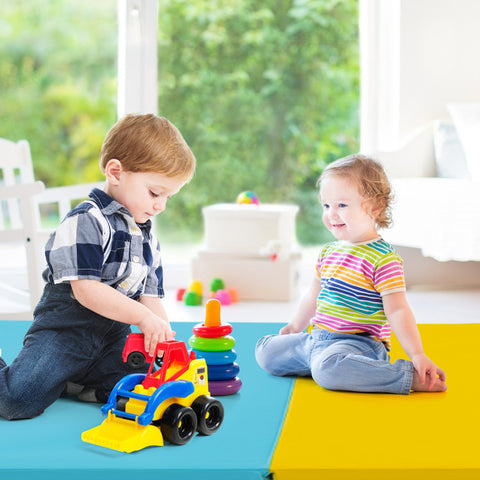News
Grip and Texture: The Unsung Heroes of Gymnastics Mat Safety
When you think of gymnastics mats, you probably picture cushioning, thickness, or foam density. But one feature that often goes unnoticed, yet has a massive impact on safety and performance, is surface grip and texture.
The grip of a gymnastics mat determines how well athletes maintain balance, execute movements, and land safely. A well-engineered surface minimizes slips and supports confidence during high-intensity routines. In this article, we’ll uncover how grip technology and texture design contribute to the science of stability in gymnastics mats.
Understanding Grip and Texture in Gymnastics Mats
Grip refers to the mat’s ability to hold traction between the gymnast’s body (or shoes) and the mat surface, preventing unwanted slipping.
Texture describes the pattern, embossing, or material finish that provides that grip.
Both aspects work together to ensure that the gymnast remains stable, confident, and protected throughout their routine, whether it’s a powerful tumbling pass or a gentle stretching session.
Why Grip Matters More Than You Think
1. Injury Prevention
Slipping is one of the leading causes of sports injuries. A mat with inadequate grip increases the risk of:
- Wrist and ankle sprains
- Muscle strains
- Falls due to lack of friction
High-friction surfaces provide the necessary resistance to help gymnasts maintain form and prevent unexpected slips during landings or turns.
2. Performance Enhancement
Grip contributes directly to movement precision. When the gymnast knows the surface is stable, they can perform advanced maneuvers — flips, handsprings, and dismounts — with more confidence.
A good grip also helps distribute force evenly, reducing unnecessary energy loss and fatigue.
3. Consistency and Control
Gymnasts thrive on consistency. Uneven or slippery mats disrupt rhythm and balance.
Premium mats use non-slip PVC or vinyl coatings to maintain uniform texture across the surface, ensuring every section performs identically — crucial for both competition and training environments.
The Science Behind Non-Slip Surface Technology
Modern gymnastics mats integrate advanced non-slip technologies that go beyond basic texture patterns.
1. Embossed Vinyl Coatings
High-quality mats often feature embossed vinyl with micro-patterns like dots, grids, or ridges.
- Improves friction without discomfort.
- Prevents sweat buildup that could reduce traction.
- Easy to clean and resistant to wear.
2. Polyurethane Grip Layers
A newer innovation includes PU topcoats that enhance surface friction while remaining soft to the touch.
- Great for barefoot exercises.
- Retains grip even under moisture or heat.
3. Dual-Surface Mats
Some professional mats feature two distinct sides —
- Smooth side: Ideal for low-intensity or stretching sessions.
- Textured side: For high-impact and dynamic movements.
This versatility allows gymnasts to switch surfaces depending on the activity.
How Texture Impacts Safety and Comfort
Microtexture vs. Macrotexture
- Microtexture: Tiny surface patterns that offer subtle grip without roughness. Best for skin contact and balance training.
- Macrotexture: Deeper embossing used in heavy training areas to prevent slippage during fast, powerful motions.
The goal is to achieve maximum traction without abrasiveness — a delicate engineering balance.
Environmental Factors Affecting Grip
Even the best mats can lose traction if not maintained properly.
- Sweat or moisture: Accumulation can reduce surface friction.
- Dust or chalk: Common in gyms, may cause slipperiness.
- Temperature changes: Heat can soften PVC, reducing texture integrity.
Regular cleaning and storing mats in climate-controlled environments preserve the grip quality for longer use.
Grip Testing and Safety Standards
Top manufacturers test grip levels using Coefficient of Friction (COF) measurements. A higher COF indicates better traction.
According to ASTM and EN 12503 safety standards, professional gymnastics mats must maintain:
- Dry surface COF: Minimum of 0.6
- Wet surface COF: Minimum of 0.5
These benchmarks ensure consistent safety, even in humid or sweaty conditions.
Choosing the Right Grip for Your Gymnastics Mat
| Use Case | Recommended Grip Type | Material Example |
|---|---|---|
| Floor exercise & tumbling | Textured vinyl | High COF embossed PVC |
| Yoga or stretching | Soft microtexture | PU surface |
| Competition setup | Balanced grip & smoothness | Dual-surface mats |
| Home training | Medium grip, easy-clean surface | EVA foam or light vinyl |
Maintenance Tips for Long-Lasting Grip
- Wipe mats after each session using mild detergent and water.
- Avoid oil-based cleaners that degrade vinyl texture.
- Rotate mat positions to distribute wear evenly.
- Ensure mats dry completely before rolling or storing.
A clean, dry surface ensures consistent traction for every training session.
Conclusion
Grip and texture might not be the first things you think about when buying a gymnastics mat, but they are among the most critical safety factors.
A well-textured, non-slip surface enhances confidence, control, and injury prevention, allowing gymnasts to focus on precision rather than stability.
By understanding how grip technology works, athletes and coaches can make informed decisions, choosing mats that not only cushion impact but also secure every step, jump, and landing.
FAQs
Q1: How can I tell if my mat’s grip is wearing out?
If you notice slipping during standard moves or smooth, glossy patches appearing, it’s time to replace or retexture the mat.
Q2: Are non-slip mats suitable for barefoot training?
Yes. Most modern non-slip vinyl and PU mats are designed for barefoot comfort and grip performance.
Q3: What’s better — smooth or textured mats?
It depends on the use. Textured mats provide better grip for dynamic routines, while smooth mats suit stretching or low-impact exercises.
Q4: Do mats lose grip over time?
Yes, due to wear, sweat, and cleaning chemicals. Regular maintenance extends lifespan and grip quality.
Q5: Are grip levels different for kids and adults?
Yes. Youth mats often have softer texture for comfort, while adult or competition mats feature higher grip resistance for control.


